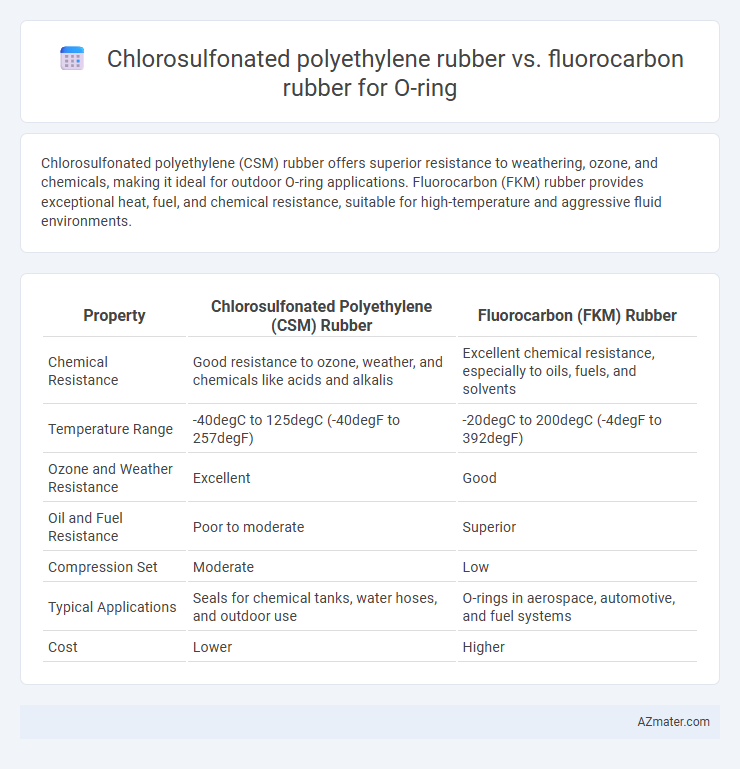Chlorosulfonated polyethylene (CSM) rubber offers superior resistance to weathering, ozone, and chemicals, making it ideal for outdoor O-ring applications. Fluorocarbon (FKM) rubber provides exceptional heat, fuel, and chemical resistance, suitable for high-temperature and aggressive fluid environments.
Table of Comparison
| Property | Chlorosulfonated Polyethylene (CSM) Rubber | Fluorocarbon (FKM) Rubber |
|---|---|---|
| Chemical Resistance | Good resistance to ozone, weather, and chemicals like acids and alkalis | Excellent chemical resistance, especially to oils, fuels, and solvents |
| Temperature Range | -40degC to 125degC (-40degF to 257degF) | -20degC to 200degC (-4degF to 392degF) |
| Ozone and Weather Resistance | Excellent | Good |
| Oil and Fuel Resistance | Poor to moderate | Superior |
| Compression Set | Moderate | Low |
| Typical Applications | Seals for chemical tanks, water hoses, and outdoor use | O-rings in aerospace, automotive, and fuel systems |
| Cost | Lower | Higher |
Introduction to O-Ring Materials
Chlorosulfonated polyethylene (CSM) rubber exhibits excellent resistance to weathering, ozone, and chemicals, making it suitable for O-rings in industrial sealing applications exposed to harsh environments. Fluorocarbon rubber (FKM) offers superior thermal stability, chemical resistance to fuels, oils, and solvents, and maintains elasticity at high temperatures, ideal for automotive and aerospace sealing solutions. The selection between CSM and FKM for O-ring materials depends on specific operational conditions such as temperature range, chemical exposure, and mechanical stress requirements.
Overview of Chlorosulfonated Polyethylene Rubber
Chlorosulfonated polyethylene (CSM) rubber offers excellent resistance to weathering, ozone, and chemicals, making it ideal for O-rings used in harsh outdoor environments. It exhibits good flexibility and durability across a wide temperature range from -40degC to 125degC, with strong resistance to oils, fuels, and acids, although its chemical resistance is less extensive than that of fluorocarbon rubber (FKM). CSM provides cost-effective sealing solutions compared to FKM, but may have lower heat and hydrocarbon resistance, making it suitable for applications requiring moderate chemical and thermal stability.
Key Properties of Fluorocarbon Rubber
Fluorocarbon rubber (FKM) offers exceptional chemical resistance, heat stability up to 250degC, and excellent weathering and ozone resistance, making it ideal for O-ring applications in harsh environments. Its low permeability to gases and superior mechanical strength provide reliable sealing performance in fuel, oil, and aggressive chemical systems. Compared to chlorosulfonated polyethylene (CSM), fluorocarbon rubber shows enhanced durability and longer service life in high-temperature and chemically aggressive conditions.
Chemical Resistance Comparison
Chlorosulfonated polyethylene (CSM) rubber offers excellent resistance to weathering, ozone, and many chemicals like acids, alkalis, and solvents, making it suitable for medium chemical exposure. Fluorocarbon rubber (FKM) outperforms CSM in chemical resistance, particularly against aggressive fuels, oils, aromatic hydrocarbons, and high-temperature chemicals, ensuring superior durability in harsh chemical environments. For O-rings, FKM is preferred in applications involving strong chemicals and extreme temperatures, while CSM is chosen for moderate chemical resistance with better flexibility and cost efficiency.
Temperature Performance and Stability
Chlorosulfonated polyethylene (CSM) rubber exhibits excellent resistance to heat and oxidation, maintaining stability in temperatures ranging from -40degC to 125degC, making it suitable for applications requiring moderate thermal endurance. Fluorocarbon (FKM) rubber, known for superior temperature performance, withstands continuous exposure from -26degC up to 204degC, with exceptional resistance to chemical degradation and heat-induced aging. For O-ring applications demanding high thermal stability and resistance to aggressive chemicals, fluorocarbon rubber outperforms chlorosulfonated polyethylene rubber in both temperature tolerance and long-term durability.
Mechanical Strength and Durability
Chlorosulfonated polyethylene (CSM) rubber offers excellent abrasion resistance and good mechanical strength, maintaining flexibility under dynamic stress, which makes it suitable for applications involving exposure to weather and ozone. Fluorocarbon rubber (FKM), known for superior chemical resistance and thermal stability, provides high tensile strength and excellent resistance to compression set, resulting in exceptional durability in harsh environments. For O-ring applications, FKM generally outperforms CSM in mechanical strength retention and long-term durability, especially under high-temperature and aggressive chemical conditions.
Applications in Industrial Sectors
Chlorosulfonated polyethylene rubber (CSM) O-rings are widely used in the automotive and chemical processing industries due to their exceptional resistance to ozone, weathering, and acids. Fluorocarbon rubber (FKM) O-rings are preferred in aerospace, oil and gas, and pharmaceutical sectors where high-temperature resistance and chemical inertness against fuels, oils, and solvents are critical. Both elastomers serve crucial roles in sealing applications, with CSM excelling in moderate temperature and chemical exposure, while FKM provides superior performance in harsh chemical and high-heat environments.
Cost Analysis and Availability
Chlorosulfonated polyethylene (CSM) rubber offers a lower cost solution for O-rings compared to fluorocarbon rubber (FKM), making it suitable for budget-sensitive applications. CSM is widely available due to its simpler manufacturing process and robust supply chain, whereas FKM O-rings tend to have limited availability and higher prices driven by complex fluoropolymer production and specialized applications. Cost-effectiveness and ease of procurement make CSM a common choice when extensive chemical resistance and high-temperature performance of FKM are not mandatory.
Environmental and Safety Considerations
Chlorosulfonated polyethylene rubber (CSM) offers superior resistance to ozone, weathering, and chemicals, making it suitable for outdoor and industrial O-ring applications with moderate environmental impact. Fluorocarbon rubber (FKM) exhibits exceptional chemical and heat resistance, and its low permeability reduces environmental contamination risks, but it requires careful handling due to potential toxic byproducts during high-temperature degradation. Both materials demand proper disposal practices, yet FKM's resistance to harsh chemicals limits environmental exposure, enhancing safety in demanding operational conditions.
Choosing the Right O-Ring Material for Your Needs
Chlorosulfonated polyethylene rubber (CSM) offers excellent resistance to ozone, weathering, and chemicals, making it suitable for outdoor applications and moderate chemical exposure, while fluorocarbon rubber (FKM) excels in high-temperature environments and aggressive chemicals like fuel, oils, and solvents. Selecting the right O-ring material depends on specific factors such as temperature range, chemical compatibility, and environmental conditions; CSM typically functions effectively up to 150degC, whereas FKM withstands temperatures up to 200-250degC. Evaluating operational demands ensures optimal sealing performance and longevity by matching O-ring material properties with application requirements.

Infographic: Chlorosulfonated polyethylene rubber vs Fluorocarbon rubber for O-ring
 azmater.com
azmater.com